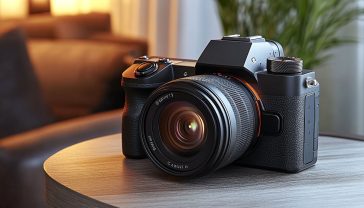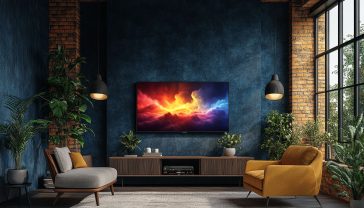The Ultimate Amazon Echo Pop UK Review: Small Speaker, Big Question
Our in-depth UK review of the Amazon Echo Pop. We test the sound quality, smart features, and compare it head-to-head with the Echo Dot. Is it a bargain?

This post may contain affiliate links. If you make a purchase through these links, we may earn a commission at no additional cost to you.
Let’s be honest, you’ve probably got an Amazon Echo device somewhere in your house already. It might be the classic hockey-puck Dot, or perhaps the newer spherical one that looks like a futuristic cricket ball. For years, the Echo Dot has been the go-to choice for anyone wanting to dip their toes into the world of smart speakers. It’s the device we buy on a whim during a Black Friday sale, the one we get for the kitchen to set timers and listen to a bit of BBC Radio 2 while making a brew.
But now, there’s a new kid on the block: the Amazon Echo Pop. It’s smaller, it’s cheaper, and it comes in some funky new colours. On the surface, it seems like a no-brainer. Amazon has taken the core of what makes the Echo Dot great, sliced it in half, and knocked a few quid off the price.
The big question is, what did they have to remove to get that price down? Is this the new budget champion for getting Alexa into every room, or is it a compromise too far? We’ve spent weeks with the Echo Pop, putting it through its paces in a typical British home—from a busy kitchen to a quiet bedside table. This is the definitive UK review. We’re going to break down everything you need to know, from sound quality to smarts, and ultimately answer that one crucial question: should you buy the Echo Pop, or stick with its slightly pricier sibling, the Echo Dot?
What Exactly is the Amazon Echo Pop?
Before we dive deep, let’s get the basics straight. The Amazon Echo Pop is Amazon’s latest entry-level smart speaker. Think of it as the new starting line for the Echo family. Its main job is to give you access to Alexa—the voice assistant that can play music, answer questions, control your smart home, and tell you terrible jokes—for the lowest possible price.
Echo Pop (Newest gen) | Full sound compact Wi-Fi and Bluetooth smart speaker with Alexa | Charcoal
- ECHO POP – This compact Bluetooth smart speaker with Alexa features a full sound that’s great for bedrooms and small spaces. Small enough to blend in and mighty enough to stand out.
- CONTROL MUSIC WITH YOUR VOICE – Ask Alexa to play music, audiobooks and podcasts from your favourite providers like Amazon Music, Apple Music, Spotify and more. Connect your smartphone via Bluetooth to stream throughout your space.
- MAKE ANY SPACE A SMART SPACE – Use your voice or the Alexa app to easily control your compatible smart home devices like plugs or lights.
- LIFE JUST GOT EASIER – Have Alexa set timers, check the weather, read the news, re-order paper towels, make calls, answer questions and more.
- ALEXA HAS SKILLS – With tens of thousands of skills and counting, Alexa can help you do more or do less – like playing relaxing sounds and testing your music knowledge.
- EERO BUILT-IN – Turn your Echo device into a Wi-Fi extender in minutes with compatible Echo and eero devices.
- ABOUT THE LIGHT BAR – Alexa doesn’t begin listening until your device hears you say “Alexa” and the light bar turns blue.
- DESIGNED TO PROTECT YOUR PRIVACY – Echo Pop is built with multiple layers of privacy protection and control, including a Microphone Off button that electronically disconnects the microphones.
- DESIGNED FOR SUSTAINABILITY – Echo Pop’s fabric is made from 100% post-consumer recycled yarn and aluminium is made from 80% recycled aluminium. 99% of its packaging is made of wood fibre-based materials from responsibly managed forests or recycled sources.
It’s designed specifically for small spaces. Amazon is pitching this for student digs, kids’ bedrooms, and secondary spots like a utility room or the corner of your home office. It’s not trying to be the heart of your home cinema or the life of a house party. It’s a simple, compact, and colourful way to have a voice assistant on hand wherever you need one.
First Impressions: Unboxing and Setting Up the Pop
Amazon has mastered the art of simple packaging, and the Echo Pop is no exception. It arrives in a small, recyclable cardboard box that feels impressively eco-conscious.
What’s in the Box?
Crack it open and you’ll find just three things:
- The Echo Pop speaker itself.
- A 15W power adapter with a UK plug.
- A small Quick Start Guide.
That’s it. It’s refreshingly minimalist. The power cable is a decent length (around 1.5 metres), giving you a bit of flexibility in where you place it.
The Five-Minute Setup
If you’ve ever set up an Echo device before, you’ll be on familiar ground. If you’re a newcomer, don’t worry—it’s about as easy as making toast.
- Plug it in. Find a spare socket and plug in the Pop. A blue light will start swirling along its top edge, and Alexa will greet you, letting you know it’s ready for setup.
- Open the Alexa app. You’ll need the app on your phone or tablet (it’s a free download for both iOS and Android).
- Add the device. The app will likely detect the new device automatically. If not, you just tap ‘Devices’, hit the ‘+’ icon, and follow the on-screen instructions.
- Connect to Wi-Fi. You’ll select your home Wi-Fi network and pop in the password.
And that’s pretty much it. The whole process takes less than five minutes. From opening the box to asking Alexa for the weather in Skegness, it’s an incredibly smooth and user-friendly experience.
Design and Build: A Stylish Splash of Colour
The most striking thing about the Echo Pop is its shape. For years, we’ve been used to circular Echos. The Pop, however, looks like an Echo Dot that’s been neatly sliced in half. This isn’t just a quirky design choice; it’s a deliberate decision that has a big impact on its sound, which we’ll get to later.
A New Shape for Echo
The semi-sphere design is meant to sit against a wall or in a corner. The flat back means it doesn’t quite fit in the middle of a room in the same way a fully spherical Dot does. It’s small, discreet, and the angled face points the speaker slightly upwards, directing sound towards you.
On top, you’ve got three simple buttons: volume up, volume down, and a microphone mute button for when you want a bit of privacy. There’s also a thin LED light bar at the top, which glows blue when Alexa is listening, red when muted, and orange during setup. It’s a clean and intuitive layout.
Small Footprint, Big Personality
The Pop is properly tiny. It measures just 99mm wide and 83mm tall, so its footprint is smaller than your average mug of tea. This makes it brilliant for cluttered bedside tables, packed kitchen worktops, or squeezing onto a bookshelf.
What really sets it apart, though, are the colours. While the Echo Dot sticks to Charcoal, Deep Sea Blue, and White, the Pop comes in the standard Charcoal and Glacier White, but also adds two new, more playful options: Lavender Bloom and Midnight Teal. These fresh colours give the Pop a bit more personality and help it blend into more varied home decors, especially in a child’s bedroom.
Built with the Planet in Mind?
Amazon is making a bigger push on sustainability, and the Echo Pop reflects this. The fabric covering is made from 100% post-consumer recycled yarn, and the plastic is 80% post-consumer recycled plastic. The packaging is also 99% wood fibre-based, sourced from responsibly managed forests or recycled sources. It’s a small step, but a welcome one for a device produced on such a massive scale.
Sound Quality: Does it Pop or Flop?
Right, let’s get to the most important part: how does it sound? A smart speaker is still a speaker, after all. And at this price, you have to manage your expectations.
The Technical Mumbo-Jumbo
First, the techy bit, made simple.
- Simplified Explanation: The Echo Pop has a single speaker inside that fires sound forwards, out of the fabric grille.
- Detailed Explanation: Inside the shell is a 1.95-inch (49.5mm) front-firing driver. This is the key difference between the Pop and the 5th Gen Echo Dot. The Dot has a slightly smaller 1.73-inch driver, but it’s positioned to fire upwards, creating a more room-filling, omnidirectional sound. The Pop’s sound is much more directional. You get the best experience when you’re sitting in front of it.
The Real-World Listening Test
We tested the Echo Pop with a variety of audio, from Radio 4 podcasts to playlists on Amazon Music and Spotify.
Podcasts and Radio: This is where the Echo Pop absolutely shines. Voices are crisp, clear, and forward. Listening to the news, a podcast like Desert Island Discs, or the football commentary on BBC Radio 5 Live is a genuinely pleasant experience. The speaker is tuned perfectly for the spoken word. If you mainly want a smart speaker for chat and information, the Pop is fantastic.
Music: When it comes to music, the results are more mixed. For casual listening in the kitchen or having some background music in your home office, it’s perfectly adequate. We played some pop tracks like Dua Lipa’s “Houdini,” and the vocals came through clearly. However, the bass is noticeably weak. There’s a bit of a thump, but it lacks any real depth or warmth. You won’t be feeling the beat drop on a dance track.
On more complex rock tracks, like something from Arctic Monkeys, the sound can get a bit muddled at higher volumes. It’s not an unpleasant sound by any means, but it lacks the richness and separation you’d get from a more expensive speaker. It’s a classic “good for the price” speaker.
How Loud Can it Go?
The Echo Pop gets surprisingly loud for its size. At 70-80% volume, it can comfortably fill a small or medium-sized room, like a typical British double bedroom. Push it to 100%, and while it doesn’t distort horribly, the lack of bass becomes even more apparent, and the sound becomes a bit thin. It’s loud enough to hear your morning alarm from under the duvet, but not loud enough to power a party.
The Main Event: Echo Pop vs. Echo Dot (5th Gen)
This is the decision most buyers in the UK will be wrestling with. The price difference is usually only around £10 (and often less during sales). So, what does that extra tenner get you with the Echo Dot? Quite a bit, it turns out.
At a Glance: Pop vs. Dot Feature Smackdown
Here’s a simple breakdown of the key differences:
| Feature | Amazon Echo Pop | Amazon Echo Dot (5th Gen) |
|---|---|---|
| Price (RRP) | £44.99 | £54.99 |
| Shape | Semi-sphere | Sphere |
| Speaker | 1.95″ Front-firing | 1.73″ Up-firing (omnidirectional) |
| Sound Direction | Directional (best in front) | 360-degree (room-filling) |
| Temperature Sensor | No | Yes |
| Motion Sensor | No | Yes (Ultrasonic) |
| Tap Gestures | No | Yes (e.g., tap to snooze alarm) |
| Eero Built-in | Yes | Yes |
| Colours | Charcoal, Glacier White, Lavender, Teal | Charcoal, Deep Sea Blue, Glacier White |
Sound: Front-Firing vs. All-Round
As we’ve discussed, this is a big one. The Pop is best placed in a corner or against a wall, where its directional sound can be aimed into the room. The Dot is much more flexible; you can place it in the middle of a coffee table or kitchen island, and it will sound broadly the same from any angle. In our tests, the Echo Dot also had slightly fuller bass, making it a better all-rounder for music.
The Missing Sensors: Why You Might Want the Dot
This could be the deal-breaker for smart home enthusiasts. The Echo Dot has two sensors that the Pop lacks:
- Temperature Sensor: This allows you to create Alexa Routines based on the room’s temperature. For example, you could set up a routine to automatically turn on a smart fan (connected to a smart plug) if the bedroom gets hotter than 21°C.
- Motion Sensor: The Dot uses ultrasonic motion detection to sense if someone has entered a room. This is brilliant for automation. You could have a routine that turns on your Philips Hue lights when you walk into the living room and turns them off when the room has been empty for 10 minutes.
The Echo Pop can’t do any of this. It can control smart devices when you ask it to, but it can’t trigger them automatically based on the room’s environment.
Tap Gestures: A Small but Mighty Feature
The final key difference is the Dot’s accelerometer, which enables tap gestures. Woken up by your morning alarm? You can just tap the top of the Echo Dot to snooze it. It’s a small quality-of-life feature, but one you quickly miss once you’re used to it. With the Pop, you have to fumble for the volume button or croak “Alexa, snooze!”
Life with Alexa: Smart Features and Daily Use
Beyond the hardware differences, the core Alexa experience is identical on both the Pop and the Dot.
Your Voice-Controlled Assistant
You get the full power of Alexa. You can:
- Set alarms and timers: Essential for the kitchen or as a bedside alarm clock.
- Ask questions: “Alexa, how many episodes of EastEnders have there been?”
- Get news and weather: You can set your preferred news source, like BBC News or Sky News.
- Listen to music and radio: It works seamlessly with Amazon Music, Apple Music, Spotify, and UK radio stations via services like TuneIn and BBC Sounds.
- Make announcements: Use the “drop-in” feature to talk to other Echo devices in your house.
The microphones on the Pop are excellent, just like on other Echo devices. Even with music playing at a medium volume from across the room, it had no trouble hearing the “Alexa” wake word.
Controlling Your British Smart Home
The Echo Pop acts as a great voice-control hub for a simple smart home. It integrates perfectly with thousands of devices popular in the UK. We used it to control:
- Philips Hue and LIFX smart bulbs.
- Tapo and Hive smart plugs.
- A Ring video doorbell.
Saying “Alexa, turn on the kettle” (via a smart plug) or “Alexa, show me the front door” (on a Fire TV) works flawlessly every time.
Can it Act as an Eero Wi-Fi Extender?
Yes, just like the latest Echo Dot, the Echo Pop has Eero Built-in. If you have an Eero mesh Wi-Fi system in your home, the Pop can act as a satellite extender, adding up to 1,000 sq ft of coverage to your network. This is a genuinely brilliant feature that adds a lot of hidden value if you’re invested in the Eero ecosystem.
Privacy Concerns: Is Alexa Always Listening?
This is a valid concern for many people dipping their toes into smart home tech. Amazon is very aware of this and has built several layers of privacy control into the Echo Pop.
- The Mute Button: The physical button on top of the Pop electronically disconnects the microphones. When you press it, the button and the light bar turn red. The device cannot hear you until you physically press it again.
- The Light Bar: The blue light bar only appears when the device has heard the wake word and is actively listening to your request. It’s a clear visual cue.
- The Alexa App: In the app’s privacy settings, you have full control. You can review and delete your voice recordings, choose how long they are saved for, and manage your data.
While any internet-connected device with a microphone carries some inherent risk, Amazon has provided robust and easy-to-use tools to manage your privacy.
The Verdict: Is the Amazon Echo Pop Worth Your Money in the UK?
After extensive testing, it’s clear that the Amazon Echo Pop is a very capable little speaker. But whether you should buy it depends entirely on what you want it for and, crucially, its price on the day you’re looking.
Who is the Echo Pop For?
- First-time smart speaker buyers on a tight budget. If you just want to try out Alexa without spending much, the Pop is the cheapest way in.
- People who want a speaker for a small, secondary room. It’s perfect for a bedroom, office, or utility room where you primarily want voice control, timers, and background audio for podcasts or radio.
- Students and kids. The low price and fun colours make it an ideal choice for a university dorm room or a child’s bedroom.
- Anyone with an Eero mesh network. The added value as a Wi-Fi extender is a huge bonus.
Who Should Skip It?
- Music lovers. If audio quality is a top priority, you should spend more. The Echo Dot is a step up, and the full-size Echo is in another league entirely.
- Smart home power users. If you want to build clever home automation routines based on temperature or motion, you need the Echo Dot. The Pop’s lack of sensors is its biggest weakness.
- Someone buying for a central location. The Dot’s 360-degree sound is far better suited for a living room or the middle of a large kitchen.
The Bottom Line
When the Echo Pop is on sale—and it frequently is during events like Prime Day or Black Friday, often dropping to around £20-£25—it is an absolute bargain. At that price, it’s a fantastic impulse buy for adding Alexa to another room.
However, at its full retail price of £44.99, its value is much murkier. For just £10 more, the Echo Dot offers noticeably better, more flexible sound and the incredibly useful smart home sensors. In our opinion, those sensors and the tap-to-snooze feature are easily worth the extra tenner.
So, our final advice is this: if you can get the Echo Pop on a deep discount, go for it. It’s a brilliant little device for the right price and purpose. But if you’re paying full price, stretch your budget that little bit further and get the Echo Dot (5th Gen). It’s a more complete and future-proof device that you’re less likely to outgrow.
Pros & Cons
Pros:
Cons:
Final Score: The Definitive Rating
- Value: 4/5 (when on sale), 2/5 (at RRP)
- Design: 4/5
- Sound: 3/5
- Features: 2.5/5
- Overall: 3.5 / 5
Further Reading
For those who want to dive even deeper into the world of smart home technology and audio reviews, we highly recommend these respected resources:
- Which?: A trusted source for impartial UK consumer reviews.
- TechRadar: Provides detailed reviews and comparisons of the latest gadgets.
- What Hi-Fi?: For the audiophiles who want in-depth analysis of sound quality.
- The Verge: Offers excellent coverage of the smart home landscape.







